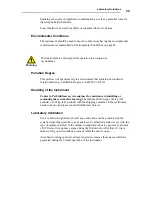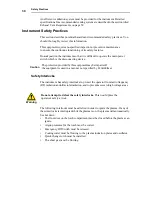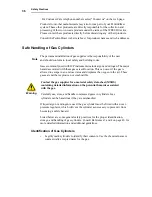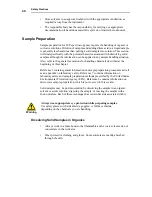
42
Safety Practices
Acid Digestions
Acid digestions, either at atmospheric pressure or at increased pressure, require
special care. Spattering and foaming of the sample/acid mixture may expose the
user to a hazard, as well as compromise the sample integrity. A digested sample
containing concentrated acid will react violently with water.
Perchloric acid and hydrofluoric acid are particularly hazardous to work with.
Perchloric Acid
Perchloric acid (HClO
4
) is extremely corrosive and a powerful oxidizing agent. It
presents severe fire and explosion hazards.
•
Use hoods, ducts, and other devices for removing vapors specifically designed
to accommodate this kind of fume. There is a severe explosion hazard if a
normal hood is used, or if the hood is not properly used and maintained.
•
Use goggles and face shields. Wear protective clothing and polyvinyl chloride
gloves.
Do not use rubber gloves.
•
Additional hazards and precautions are given in References 1, 2, 9, 10 and 11.
Hydrofluoric Acid
Hydrofluoric acid (HF) is also used for digestions. It is toxic and extremely
corrosive. Hydrofluoric acid will readily burn skin, and if the fumes are inhaled,
lung tissue. Burns may not be immediately painful or visible. Contact with eyes
could result in blindness.
Before using perchloric acid, you should be thoroughly familiar with
its hazards and safe handling practices.
Observe the manufacturer's
recommendations for use, storage, and disposal.
Before using hydrofluoric acid, you should be thoroughly familiar
with its hazards and safe handling practices.
Observe the
manufacturer's recommendations for use, storage, and disposal.
!
Warning
!
Warning
Summary of Contents for OPTIMA 8000
Page 1: ...OPTIMA 8000 Customer Hardware and Service Guide ICP OPTICAL EMISSION Return to Document Menu...
Page 2: ......
Page 3: ...Optima 8000 Customer Hardware and Service Manual...
Page 12: ...Contents 10...
Page 18: ...16 Indicates the ON position of the main power switch Indicates alternating current...
Page 24: ...22 Figure C Location of warning labels in the sample compartment 1 2...
Page 28: ...26...
Page 29: ...Safety Practices 1...
Page 49: ...Preparing Your Laboratory 2...
Page 61: ...Preparing Your Laboratory 60...
Page 62: ...System Description 3...
Page 89: ...Installation 4...
Page 136: ...Maintenance 5...
Page 241: ...Troubleshooting 6...
Page 264: ...Error Messages 7...
Page 284: ......
















































